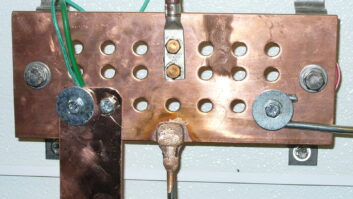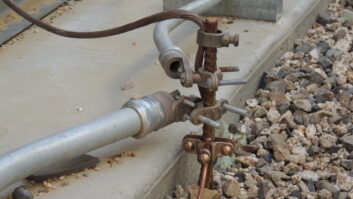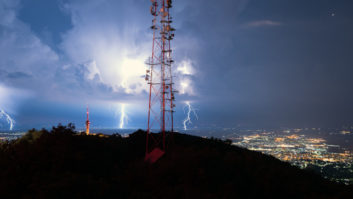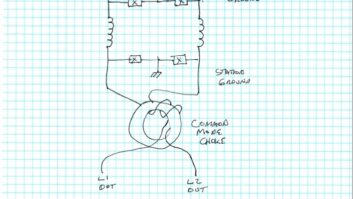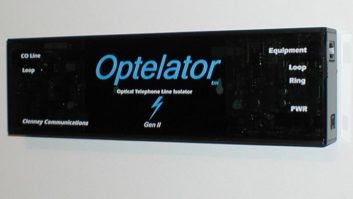Lightning protection
Aug 1, 2002 12:00 PM, By John Battison, P.E., technical editor, RF
The radio engineer does his best to prevent its intrusion into his equipment, but having a steel structure extending from 150 feet to 1,000 feet in the air invites lightning strikes. Nevertheless, with proper engineering precautions such structures can survive intense lightning attacks. The Eiffel Tower, which is nothing more than a solid-steel lightning conductor, falls in the same category and it survives.
The most important concern in tower construction is complete and thorough bonding so that there are no areas for excessive heat to build due to resistance, and no sections that could present high reactance to the fast-rising lightning strike.
Taking charge
Most people have seen summer lightning or heat lightning; lightning merely flashing within the clouds often without thunder. The up-and-down drafts within the clouds in a lightning storm provide the mechanism that generates the electric charge. This charge forms on the underside of the clouds, and is called the base charge. This induces a charge of the opposite sign on the ground.
If the area beneath the storm cloud includes a radio tower, the ground charge will be concentrated up the tower. When the difference between the top of the tower and the base of the cloud becomes high enough, the air dielectric between the two breaks down, a lightning strike occurs and the cloud is discharged to ground. If the tower is well grounded and has been properly bonded, no damage will occur to radio equipment.
Lightning dissipaters, such as this lightning spur, reduce the potential for a lightning strike between the tower and storm cell by transferring electrical charge to the adjacent ionizing air molecules, thus reducing the probability of a lightning strike. Photo courtesy of ERI.

Watching a lightning strike is interesting. Photographs of lightning strikes have shown leaders that appear just before the discharge occurs. These leaders seem to develop downwards from the underside of the cloud in leaps of about 150 feet. They continue to extend toward the ground until, when several hundred feet from the ground, streamers begin to rise from the ground toward the leaders. When the leaders and streamers connect, the ionized path formed provides the path for the lightning strike.
If we could prevent the leaders and streamers from making contact we might prevent lightning strikes. Aircraft have what are known as wicks on the trailing edges. These wicks serve the same purpose as the lightning rods on the top of radio towers. They allow the aircraft to discharge itself continually as it flies. In the case of the lightning rod, the sharper the point the better the lightning rod works.
As the diameter of a conductor decreases, the voltage gradient increases toward the point. When the voltage at the end of the rod is sufficiently high it will bleed-off some of the induced lightning charge on the ground, streamers will be reduced or eliminated and the likelihood of a lightning strike is reduced. A corona develops at the tip of the rod, which sometimes can be seen.
An ounce of prevention
Several companies offer lightning protection devices that use a series of sharp-pointed electrodes mounted on the top of the tower. These are known as static ground charge dissipation systems and can be effective. It is also common practice to install a static discharge choke from the base of the tower to ground. However, if the standard ball gap is not properly adjusted it can cause more harm than good.
AM towers, with their large and low-resistance ground systems, seem to suffer less damage from lightning. Once a lightning strike enters the tower, its path toward ground is determined by the reactance in its path. Because the rise time of the wavefront is rapid a reactance that might normally be considered insignificant can develop catastrophic voltages, which can bypass ground paths and jump to adjacent objects.
Different ground points can result in a voltage differential between devices.

A lightning strike on a power line can enter through the line itself. Regardless of the amount of lightning activity in a station’s local area, surge protectors are essential. Some power lines contain intermittent spikes caused by load changes, as well as severe over-voltage surges caused by lightning. The surge protector should be located where the line enters the building, and additional surge protectors on individual pieces of equipment are advisable. It is essential that surge protectors be connected as closely as possible to the equipment to be protected, and in no case should long connecting cables be used.
There should be only one ground system connection. Otherwise it is possible for high voltages to develop between them in the event of a heavy strike. The extensive ground system required by AM transmitters sometimes provides an ideal unity ground. However, all connections to this ground should be made with a flat, wide copper strap to ensure a low-impedance connection. If possible, bring all ground connections close together so that there can be no potential differences between them.
If a lightning strike occurs near the transmitter building a voltage gradient will be produced across the area. If these three lines are brought through widely separated ports, surprisingly large voltages can develop between them if they are grounded in three places. Locating them together and connecting them to the same ground should reduce or eliminate lightning damage.
E-mail Battison at[email protected].





